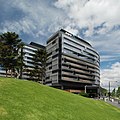Selected projects
The firm's first major project was the Art Deco building at 2 King William Street for the Bank of New South Wales. [5]
Australia
- Adelaide Festival Centre, Adelaide, Australia, 1973
- Olympic Park railway station, Sydney, Australia, 1998
- North Ryde railway station, North Ryde, Australia, 2009
- ANZ Centre, Docklands, Australia, 2010 [9]
- Fiona Stanley Hospital, Perth, Australia 2013
- National Institute of Dramatic Art Graduate School, Sydney, Australia, 2015 [10]
- Perth Stadium, Perth, Australia, 2017
- Western Australian Museum (WA Museum Boola Bardip), Perth, Australia, 2019, Designed with OMA [11]
- UWA EZONE Student Hub, Perth, Australia, 2020 [12]
- AMRF First Building (as part of the Aerotropolis Masterplan for Western Sydney Airport), Sydney, In progress [13]
- Melbourne Arts Precinct Transformation, Melbourne, In progress [14] [15]
United Kingdom
- Sky UK London HQ (Sky Central Workplace), London, 2016 [16]
- Brighton Business School, Brighton, 2021 [17]
- First Light Pavilion Visitor's Centre (Jodrell Bank Observatory), Macclesfield, 2022 [18]
China
- HSBC QRC Suites, Hong Kong, 2021
Gallery
- Olympic Park railway station, Sydney, Australia
- North Ryde railway station, Sydney, Australia
- ANZ Centre, Docklands, Australia
- Western Australian Museum (WA Museum Boola Bardip), Perth, Australia



